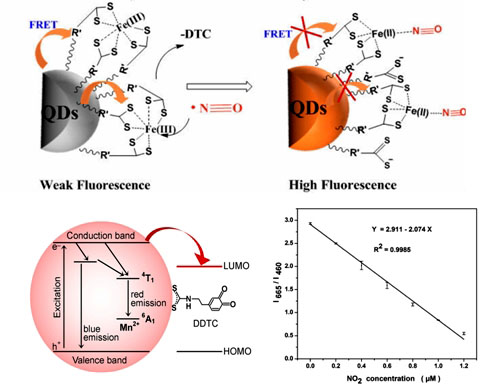Approved by overseas cooperation projects and National major scientific program, Wang Suhua Team of IIM has achieved great progress in analysis and detection of gaseous contaminants. New methods and techniques of highly selective visual detection have been developed specific to trace sulfur dioxide and its derivatives, nitrogen oxides, hydrogen sulfide, and heavy metal ions. Thus, the new method of quantify natural polyphenols antioxidant capacity has been further developed. The research result has been published in Analytical Chemistry,2014,86,9381; Analytical Chemistry,2014, 86,5628;Analytical Chemistry,2014, 86, 11727;J. Agric. Food Chem.2014, 62, 5253;ACS Appl. Mater. Interface,2014, 6, 21461; Analytical Chemistry,DOI:10.1021/ac503474x; ACS Appl. Mater. Interfaces,DOI: 10.1021/am507307g.
As the main atmospheric contaminants, the pollutant gas such as sulfur dioxide and nitrogen oxides can be converted into the fine partical as sulphate and nitrate through photochemical and oxidation process. The combined contaminant haze is eventually caused, and consequently efficient and effective identification and monitoring approaches against it have been urgently required to monitor and control the pollutant sources.
Staff of Wang Suhua Team designed multiple sensitive probes specific to different gaseous contaminant with a purpose of efficient highly selective and sensitive recognition on the spot. (1) Based on quantum dot surface molecule engineering and fluorescence resonance energy transfer, a metal complex nano-fluorescent probe which makes specific response to nitric oxide has been designed. The highly selective visual detection method of nitric oxide, which developed by recognition of fluorescence quenching and lighting, and the visual detection limit of nitric oxide could reach 10 ppm.(2) Selective visual detection of nitrogen dioxide in gaseous environment has been achieved by developing the ratio fluorescence nanosensor method. Highly sensitive visual response has been obtained by fluorescence signal’s gradual changes from red to blue. Portable gaseous sensor, made by further using air bottle, could detect 1 ppm nitrogen dioxide gas.(3) Highly selective detection of sulfur dioxide and its derivatives has been developed by using the compatibility of functional organic molecule and fluorescence carbon dots. Specific addition reaction of functional molecule and sulfur dioxide regulate the fluorescence resonance energy transfer, by which sulfur dioxide could be highly selective detected. The detection limit of the probe could reach 1.8µM without any interference of other coexisting ions or gases.(4) By introducing nitrogen dioxide fluorescence method into antioxidant measurement, a novel, convenient, sensitive antioxidant capability method has been proposed to quantify the radical capture ability of multiple natural antioxidants such as flavanone and polyphenols. By the standard of epicatechin, antioxidant reaction rate constant of nine polyphenols chemicals, which has been calculated by initial reaction rate kinetic equation, quantize its antioxidant ability and construct the relative equation of structure and activity. The visual methods mentioned above could efficiently detect the relevant gaseous contaminant on the spot without relying on large instruments, therefore it’s of great importance in environmental protection and detection.
All the mentioned research projects have been completed by Sun Jian, Yan Yehan, Zhu Houjuan, graduate students from University of Science and Technology of China, Sun Mingtai, Yu Huan, Zhang Kui from Institute of Intelligent Machines, CAS, and Yan Yan、C. K. Tan、S. Krishnakumar, graduate student of Prof. Huang Dejian from National University of Singapore.

The reaction theory and signal of different gaseous contaminant probe.
